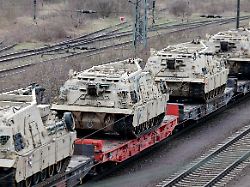Tank distributor in Wiesbaden
A US barracks coordinates arms deliveries to Kiev
By Kevin Schulte
September 10, 2023, 11:35 a.m
The West has been supplying Ukraine with equipment and military equipment for a year and a half. The deliveries are coordinated from a US barracks in Wiesbaden. As soon as tanks and howitzers are at the border, the Ukrainian railway takes over.
It’s not just what happens at the front that is crucial for the course of the war in Ukraine. Logistics also plays an important role for the warring parties. Every single delivery is coordinated in the Lucius D. Clay barracks of the US Army in Wiesbaden. This is the headquarters of the IDCC, the “International Donor Coordination Center”, which coordinates military aid from over 50 countries. Since March last year, around 200 experts from Ukraine’s supporting countries have been ensuring that war equipment and equipment arrive where they are needed.
As the war progressed, the tasks changed. At the beginning of the war, the main focus was on the delivery of small arms and anti-tank equipment, said Brigadier General Chris King, head of the Coordination Center, the military intelligence platform “Defense News”.
Most NATO countries and other allies are now known to also provide highly developed military equipment and heavy tanks. The Clay barracks in Wiesbaden have gone from being a coordination assistant to a central contact point for military support for Ukraine.
Hub in Poland
Those involved describe the process like this: The Ukrainians submit requests for certain equipment and weapons. Wiesbaden uses a register to check whether and to what extent the needs can be met by the donor countries. The IDCC then organizes the logistics up to the Ukrainian border. Wiesbaden is currently planning deliveries up to two months in advance. Once a shipment leaves a country’s warehouses, it takes about two to four days to get where it’s supposed to go, Duke Heinz said “Defense News” quoted. The rear admiral is the logistics manager for the part of the US Army stationed in Europe.
However, the exact delivery routes remain secret so as not to present the weapons to Russia. It is likely that there are different routes through which the weapons are brought to Ukraine, which change regularly. In any case, an important hub for material from the USA is the airport in the Polish city of Rzeszów, just 75 kilometers from the Ukrainian border. For security purposes, a Patriot missile system now protects the airport.
Since the start of the war – as of the end of July – over 800 flights have brought military equipment to the Ukrainian border. Since tanks and howitzers have been on the transport lists, more and more trains and ships are being used.
The logistics center in Wiesbaden not only takes care of the transport of weapons and equipment, but also coordinates the training of Ukrainian soldiers on tanks, howitzers and other weapons.
IDCC boss King specifically describes the process using the example of a howitzer delivery: This was donated to Kiev by Great Britain. Because New Zealand uses the same howitzers in its military, it was able to provide spare parts. Members of the New Zealand army also helped train the Ukrainian soldiers. The training was again completed in Great Britain. The USA ultimately supplied ammunition and vehicles to tow the howitzers.
“The challenge is to coordinate the training plan with the equipment deliveries,” says logistics manager Heinz, adding that his team is not yet aware of any deliveries that ended up on the black market and did not reach their destination.
Railways work despite the war
As soon as the material arrives in Ukraine, it is transported by rail. The huge country has a dense rail network. Of course, Russia knows where the routes are and bombards railway lines and stations with rockets. Nevertheless, Ukraine has so far managed to “maintain its railway system, repair damage quickly or use alternative routes,” said arms expert Torben Schütz from the German Council on Foreign Relations (DGAP). “South German newspaper” said.
A Ukrainian train driver praised the resilience of the Ukrainian railways on ntv with these words: “We tell a joke here in Ukraine: If it snows in Germany, the trains stop running. If it snows in Ukraine and the Russians still attack “The train is half an hour late”.
As a rule, the trains do not bring the weapons directly to the front; instead, the material is loaded from trains onto trucks outside the range of Russian artillery and taken to the combat area. Tanks, on the other hand, can of course also cover the last few kilometers themselves.
However, the best military equipment is of course not enough if the Ukrainian soldiers are not adequately supplied. Food, clothing, medicine. All of this must also be guaranteed. Transporting injured people must also be coordinated. Anyone who is wounded at the front is first treated on site, but then has to be taken to a real hospital as quickly as possible. Here too, the railway is important: according to “SZ”, more than half of the wounded are transported by train.
“Learned something again” is a podcast for those who are curious: Why would a ceasefire probably just be a break for Vladimir Putin? Why does NATO fear the Suwalki Gap? Why does Russia have iPhones again? What small behavioral changes can save 15 percent energy? Listen in and get a little smarter three times a week.
You can find all episodes in the ntv app RTL+, Apple Podcasts and Spotify. “Something learned again” is also included Amazon Music and Google Podcasts available. For all other podcast apps you can use the RSS feed.
You have a question? Please send us an email to [email protected]
